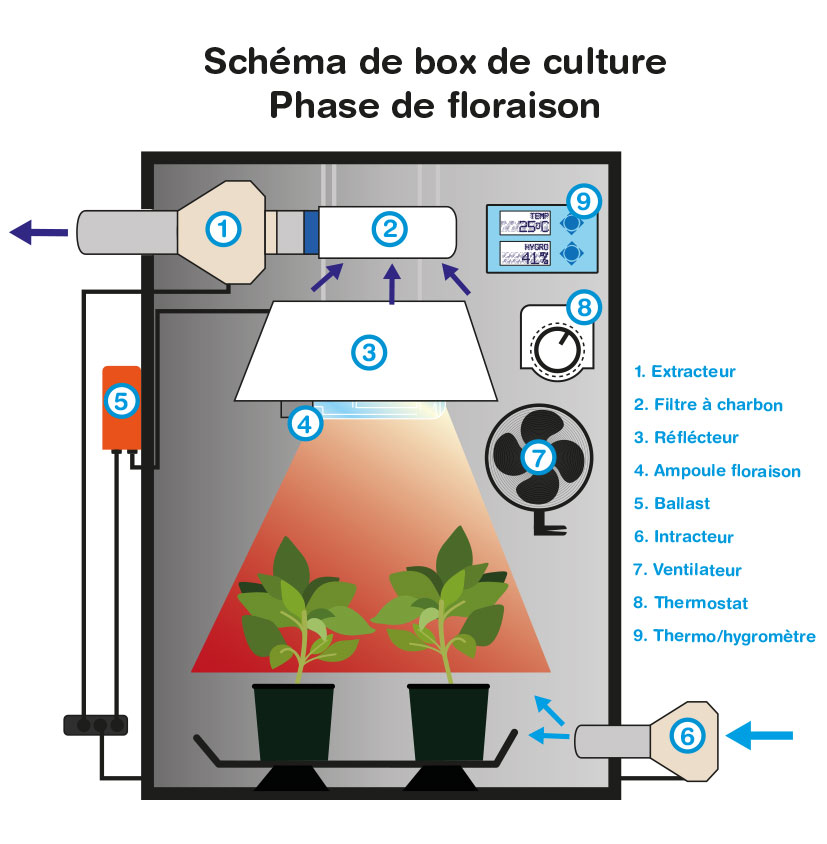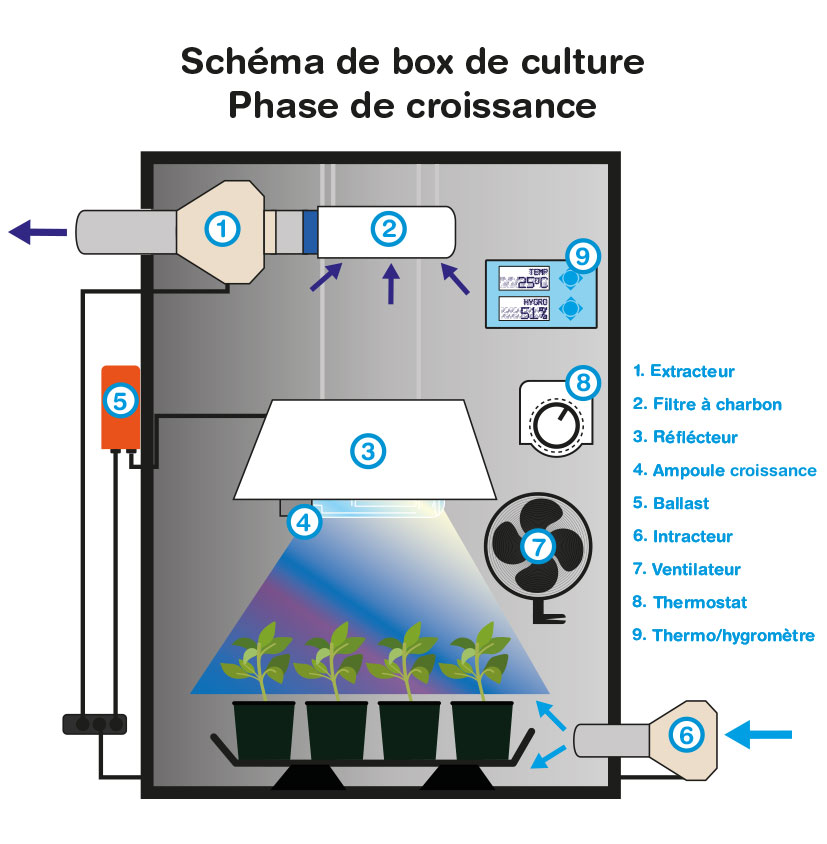Boxes: growing at home, indoors
Gardening at home, or starting an indoor cultivation, requires a minimum of space and installation beforehand. And the most common is to install a stall. Let's find out together what this is all about and how to go about it
What is a "box"?
In indoor cultivation, a stall is a tent or a grow room. Inside, by reproducing the climatic conditions of the outside, you can, for example, grow your own tomatoes, herbs or orchids. You can place it in your home, in a room, in the basement or in your garage, where the temperature remains constant.
>>> see examples of horticultural rooms: Cristal Room Secret Jardin 60, Grow-Tent Silver 40, Superbox Mylar 80, Ecotent 150
How is it made up?
A culture chamber is made of canvas (reinforced or not), held together by means of metal bars joined by plastic or metal fittings. Usually equipped with one or more reclosable doors with zippers, it is generally black, airtight and watertight. The purpose of this is to recreate in your home the external conditions close to nature. Thus designed, it allows you to establish and control a certain climate without disturbance from the outside (you are the master of the seasons):
- - light >>> see Horticultural lamps
- - air >>> see Ventilation
- - temperature and humidity >>> see Climatic Control
- - and even protection against unwanted insects >>> see Insect treatment
Its internal material, made of mylar or a simple white tarpaulin, reflects the light of your horticultural bulbs (amplified by reflectors). This coating also promotes appreciable heat conservation for plants.
In addition, depending on the brand or model, the hydrocultivator tent is equipped with small windows, holes or socks (a type of "hole pocket"): these are passages for cables and connections, as well as for air extraction/intraction and to facilitate the passage of ventilation ducts.
Of course, if you invest a little more, you will be able to find more resistant models that offer other options as well:
- - larger dimensions,
- - storage pockets,
- - suspension straps for attaching a lamp,
- - of the side doors,
- - ventilation grilles,
- - of the floors,
- - separations to have 2 tents in 1, or even more, etc..
- - with a rigid structure, designed like real cupboards
>>> discover Secret Jardin (large size), Dark Propagator 120 2.5, Superbox 150,G-Tools
"wardrobe" tent There is another alternative to have a "hard room" to grow your indoor garden. This involves directly investing one of your rooms and/or placing solid partitions in it. This is a solution to the soundproofing problem and to the inconvenience caused to your neighbours or your own comfort. Indeed, a fabric is less effective against noise pollution than, for example, a ventilation system (noise of extractors) or lighting (noise of ballast). Also, during the flowering phase, the plants may smell more or less strong. Remember to equip yourself for the odour control (with a carbon filter, for example).
How do you know where to place and furnish your stall?
It all depends on the type of indoor garden you want to create and the space you have at home. Because you have to take into account that a tent has a certain basic volume, even the smallest one. Your growing space must therefore be thought out in advance.
The minimum height required for a grow room is about 1.40 m. Please note that, because of the pots, the plants are at least 30 cm above the ground. And that the lighting must be suspended at a distance of about 30 cm from the roof of your tent. Add to this the distance plant-lighting.
A tent can be of several sizes, depending on your needs. The most comfortable height is 2m, which gives you enough room for more. Because you have to think about the development of your plants. And yes, because a garden of shoots or mother plants during the growing phase takes up less space than during the flowering phase.
That's why, for a permanent culture, it is recommended to have one space for growth and another dedicated to flowering. To do so, some solutions:
- - one of them is to divide the growing area in two, if the space in the stall allows it. Moving the pots from a growing to a flowering arrangement requires more space, practice and investment. This installation can be done as you go along, but it is a good idea to prepare for it at the beginning of your cultivation.
- - Another requires even more space and experience: a room for growth and a room for flowering. For good results, two different climates will have to be managed simultaneously.
- - Or, as mentioned above, the Grow-Tent Dual Silver 2 in 1 with one growing space below a larger one for flowering. It is also possible to have more compartments in a tent: we have an example of this with the type Secret Garden Lodge.
What can there be in a box?
Example of a growing tent dedicated to growth
(where it is possible to put germinations, cuttings, and/or mother plants) :
- temperature: between 20°C and 25°C during the day - around 18°C at night
- hygrometry rate: between 50% and 70%
- lighting: cold/blue light under reflector (glazed, ventilated, or cooltube), with for example a 110W double fluorescent compact lamp, MH, neon, an Ecolight, or Leds
- climate: extractors, fans, charcoal filter...
etc....
Example of a growing tent dedicated to flowering

- temperature: between 25°C and 27°C during the day - around 18°C at night
- hygrometry rate: between 40% and 60%
- lighting: warm/red light under reflector (glazed, ventilated, or cooltube), with for example an HPS 400W lamp, or Leds
- climate: extractors, fans, carbon filter...
etc....
Now that you have the basics, all you have to do is get started! For more information, we advise you the beginner's guides Initiation to Hydroponics (Succeed indoors) or the very complete Hydroponics for all which will make you the master of hydroponics!
Make Hydroponics rhyme with Savings, thanks to Indoor Discount !
